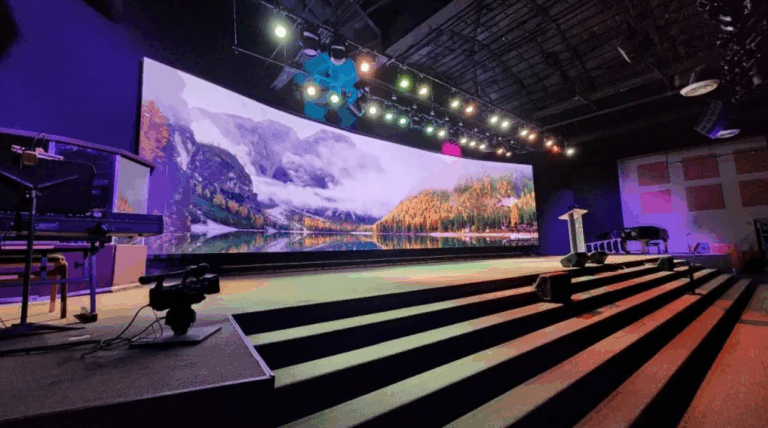In modern display technology, LED screens and LED walls are two common and widely used concepts, especially in areas like advertising, commercial displays, sports venues, and stage performances. Although these terms are often used interchangeably, there are some distinctions in terms of application and construction. This article will help clarify the definitions, main differences, and application scenarios of LED screens and LED walls.

1. Definition of LED Screen
An LED screen (LED Display) typically refers to a screen that uses LED (Light Emitting Diode) technology for display. It is a display device primarily used to convey information, display images, videos, and advertisements. LED screens come in various forms, including small displays, televisions, digital signage, etc. The size, resolution, and functionality of LED screens may vary depending on the specific use case and requirements.
LED screens can be divided into:
- Indoor LED screens: Typically used in indoor environments such as shopping malls, stores, exhibitions, meeting rooms, etc.
- Outdoor LED screens: Used for outdoor advertising, public spaces, sports events, etc., often with higher brightness and protective capabilities.
- Transparent LED screens: Used in storefront windows or glass facades to display dynamic advertisements or information.
2. Definition of LED Wall
An LED wall is a large-screen system made up of multiple LED display modules that are joined together. It is typically used in scenarios that require displaying ultra-large images or special forms of content. The modular technology allows the screen to be assembled like a puzzle, forming a larger display area. LED walls are widely used in stage performances, TV shows, billboards, sports events, and as background walls for large-scale activities.
Key features of LED walls:
- Modular assembly: Multiple LED modules are stitched together to create a large display area.
- Flexibility: LED walls can be customized in size and shape based on actual needs, such as curved or circular configurations.
- High brightness and clarity: LED walls usually feature higher brightness and resolution, ensuring clear visuals in large venues.
3. Key Differences Between LED Screens and LED Walls
Although both LED screens and LED walls use LED technology for display, there are significant differences in terms of structure, application, and functionality.
| Comparison Item | LED Screen | LED Wall |
|---|---|---|
| Structure | Single display, can be fixed or adjustable in size | Made of multiple LED screens joined to form a large display |
| Application | Small displays (e.g., digital signage, TV screens, ads) | Large displays (e.g., stage backgrounds, big billboards) |
| Display Effect | Suitable for displaying single content, balanced in resolution and brightness | Suitable for large-scale content, requires precise stitching and high resolution |
| Installation Method | Simple installation, typically placed in a single location | Complex installation, requires assembling multiple modules, adjustable size and shape after setup |
| Flexibility | Relatively fixed, usually lacks flexibility or variation | Highly flexible, can be customized in size, shape, and content |
| Cost | Relatively low, suitable for personal users or small businesses | Higher cost due to the need for multiple screens, suited for large enterprises or events |
| Maintenance & Replacement | Easier to maintain, usually involves replacing individual screens | More complex maintenance, may require dismantling modules for repairs |
| Content Display | Typically displays a single content, such as videos, ads, or information | Can display large backgrounds, dynamic images, or multiple independent contents |
4. Application Examples of LED Screens and LED Walls

Example 1: LED Screens in Shopping Malls
In commercial retail settings, LED screens are commonly used for advertising and information display. For instance, a large shopping center might install several LED screens at the entrance to play brand advertisements, promotional information, and mall event notifications. The LED screens inside the mall are usually designed as fixed rectangular screens, allowing customers to easily access relevant information without requiring large-scale assembly. These applications typically need higher resolution but don’t require extremely large display areas.

Example 2: LED Walls in Concerts
In large concerts and stage performances, LED walls have become essential equipment. To enhance the immersive experience for the audience, concerts often use multiple LED screen modules to form a massive LED wall. This LED wall displays concert background videos, live footage of the performers, and dynamic effects to help elevate the overall atmosphere. LED walls are particularly suited for this type of scenario, where large and flexible display areas are needed.

Example 3: LED Walls in Sports Venues
In sports venues, LED walls are often used to display match information, instant replays, and advertisements. A large sports stadium, such as a football or basketball arena, usually installs huge LED walls at each corner to show scores, advertisements, and live video feeds. The high brightness and clarity of LED walls ensure that even in strong sunlight, spectators can clearly see the displayed content. Sports LED scoring board: an indispensable technology for professional events!
5. Conclusion
Although both LED screens and LED walls use LED display technology, they differ in their application scenarios, structure, installation methods, and cost. LED screens are typically used for smaller or medium-sized display needs, are easy to install, and are cost-effective, making them suitable for personal or small business use. In contrast, LED walls are ideal for large-scale display scenarios, such as stage performances, giant billboards, or sports venues, offering greater flexibility and display quality, but at a higher cost and more complex installation.
Understanding the differences between these two options will help you make the right choice based on your specific needs. If you just need a small advertising display, an LED screen may be more suitable. However, if you need a large-scale display system, an LED wall is undoubtedly the better choice.





